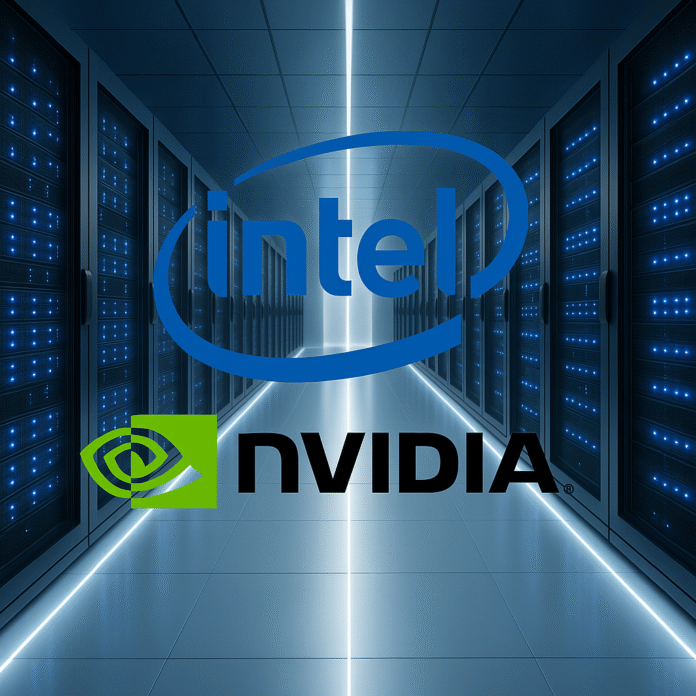In a seismic pivot for the semiconductor industry, Intel Corporation and NVIDIA Corporation announced on September 18, 2025, a strategic partnership to jointly develop custom data‑center and PC products that blur the lines between CPU and GPU ecosystems.
At the centre of this deal is NVIDIA’s signature high‑speed interconnect, NVLink, being incorporated into future Intel‑designed CPUs — both for enterprise servers and consumer PCs. Intel will design custom x86 processors tailored for NVIDIA’s AI infrastructure platforms, and in turn, produce PC system‑on‑chips (SoCs) that integrate NVIDIA RTX GPU chiplets.
Financially, the deal comes with a major investment: NVIDIA will purchase approximately US $5 billion in Intel common stock.
Shifting dynamics in the chip world
This collaboration signals more than just a joint product roadmap. It reflects several deeper industry currents.
1. Blurring of traditional boundaries
For decades, Intel and NVIDIA were locked in distinct ecosystems: Intel with x86 CPUs, NVIDIA with GPUs and accelerated compute. Now, the two are merging architectures — Intel CPUs wired with NVIDIA interconnect and GPUs — suggesting a move toward heterogeneous computing platforms where CPU and GPU are tightly coupled rather than simply co‑located.
2. Leveraging complementary strengths
Intel brings its x86 legacy, fabrication scale (and in‑house foundry ambitions), and broad platform foothold in PCs and servers. NVIDIA brings leadership in AI acceleration, massive GPU‑ecosystem momentum and its NVLink interconnect technology. By collaborating, they aim to combine these strengths for competitive advantage.
3. A strategic response to competitive pressure
Both companies face headwinds: Intel has struggled in discrete GPU and foundry ramp‑up, while NVIDIA faces criticism for GPU dominance and supply‑chain dependencies. This deal gives Intel a fresh anchor, and gives NVIDIA deeper roots in CPU/SoC design and ecosystems.
Implications for the data‑center and PC markets
For data‑centers, this means that future AI server architectures may no longer treat CPU and GPU as separate islands. With NVLink integrated at the CPU level, latency, bandwidth and software stack cohesiveness could all change. For instance, NVLink has previously delivered up to 1.8 TB/s bandwidth in other architectures.
On the PC front, the integration of RTX GPU chiplets on Intel SoCs could create more tightly integrated, high‑performance materials for gaming, content creation and AI‑enabled consumer platforms. This may accelerate the “AI PC” era.
Software & ecosystem fatigue often accompany hardware shifts. Developers may face new APIs, driver models, heterogeneous memory domains and novel packaging technologies. But the potential for unified CPU‑GPU stacks built from the ground up is compelling.
Challenges ahead
That said, there are caveats.
-
Multi‑generation commitments are ambitious: designing custom silicon, packaging, yield ramp‑up, ecosystem support and software toolchains will all take time. Some reports indicate PC‑focused SoCs may not arrive until 2027‑2028. Tom’s Hardware
-
Integration risk is real: Packaging GPU chiplets onto Intel SoCs, merging NVLink into x86 CPUs, and ensuring performance/power/cost targets all align is non‑trivial.
-
Competitive responses: Other players like Advanced Micro Devices (AMD), Broadcom Inc. and emerging Arm‑based platforms may accelerate their own strategies in reaction.
Closing thoughts
The Intel‑NVIDIA collaboration marks a turning point: the era of siloed CPU versus GPU is giving way to platforms where CPU, GPU and interconnect are designed as an integrated whole. It reflects the reality that modern computing—especially AI—demands tight coupling, massive bandwidth, and coherent software stacks.
For enterprises, this partnership signals that the hardware stack might soon become more unified, which can simplify AI deployments, accelerate performance gains and open up new form‑factors. For PC users and gamers, it points to future machines where CPU and GPU aren’t just co‑present but deeply integrated.
As such, the “revolution” remains ahead rather than here. The real test will be how quickly the companies execute, how the ecosystem adopts the new platforms, and how compelling the first‑wave products become. If all goes well, we could be witnessing the foundation of a new computing architecture—one where the old boundaries dissolve and high‑performance computing becomes more seamless and accessible.
References
-
NVIDIA and Intel to Develop AI Infrastructure and Personal Computing Products, NVIDIA Newsroom — Category: Press Release; URL: https://nvidianews.nvidia.com/news/nvidia-and-intel-to-develop-ai-infrastructure-and-personal-computing-products NVIDIA Newsroom
-
Nvidia to invest $5bn in Intel, companies will develop custom CPUs together, Data Center Dynamics — Category: News; URL: https://www.datacenterdynamics.com/en/news/nvidia-to-invest-5bn-in-intel-companies-will-develop-custom-cpus-together/
-
*NVIDIA and Intel announce strategic collaboration to advance data‑center and PC computing
Serge Boudreaux – AI Hardware Technologies
Montreal, QuebecPeter Jonathan Wilcheck – Co-Editor
Miami, Florida -
Post Disclaimer
The information provided in our posts or blogs are for educational and informative purposes only. We do not guarantee the accuracy, completeness or suitability of the information. We do not provide financial or investment advice. Readers should always seek professional advice before making any financial or investment decisions based on the information provided in our content. We will not be held responsible for any losses, damages or consequences that may arise from relying on the information provided in our content.



